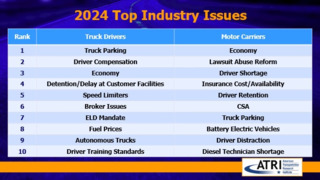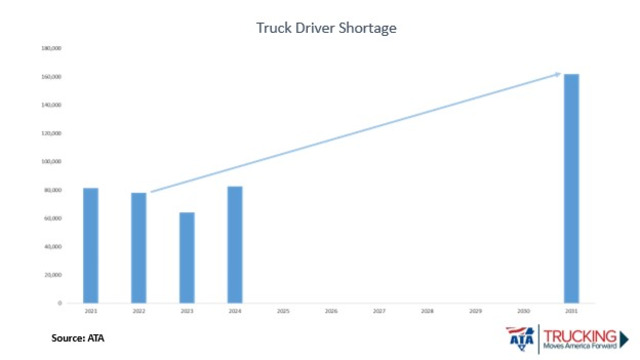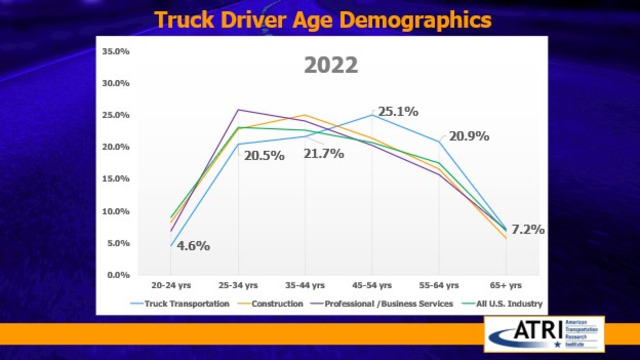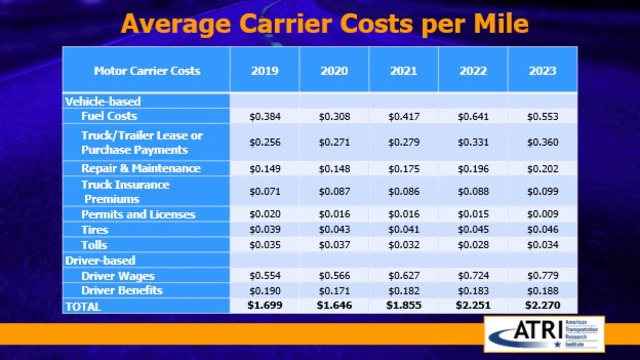
Rarely has a single issue in trucking permeated every aspect of the industry’s successes and failures as has the truck driver shortage. While the issue is a perennial “Top 10” issue on the American Transportation Research Institute’s (ATRI) annual survey of critical issues in trucking, the truck driver shortage has experienced the perfect storm of growing pressures. External pressures include two straight years of a trucking industry recession, growing cost centers led by insurance and regulatory costs, legalization of marijuana and the continuing retirement of baby boomers and soon-to-be Gen Xers.
Another 800-pound gorilla in the room is the industry’s poor image among the general populous. People unfamiliar with how sophisticated new truck tractors are, or how well truck drivers are paid, still have an impression that trucking is a dinosaur industry stuck in the 20th century. In reality, modern trucks are loaded with cutting-edge technologies and safety systems. New over-the-road (OTR) trucks have sleeper berths that have every conceivable luxury that a small apartment might have. Furthermore, truck driver compensation has gone up annually by double digits the last few years. Walmart announced that anyone with a Class A commercial drivers license and two years of good driving history can start at $106,000 a year.
But still many driver seats sit empty. Prior to this recent trucking industry recession, there wasn’t a motor carrier in the country who didn’t turn down a profitable revenue load because they couldn’t move the truck from Location A to Location B. In ATRI’s Top Industry Issues survey, the truck driver shortage has been the No. 1 issue for motor carrier executives in five of the last seven reports. However, it is nowhere to be seen on the truck drivers’ Top 10 list.
 American Transportation Research Institute (ATRI)
American Transportation Research Institute (ATRI)
While the truck driver shortage is a clear reality for motor carriers, there are academics and even truck driver associations who insist that, from a technical standpoint, the truck driver shortage is not real. The logic being that, once all the myriad issues referenced above are addressed, the truck drivers will come racing back into trucking. Whether that is true or not, the issues that dissuade people from entering, or staying in trucking are not insignificant.
Trucker Retirements are Growing
A large percentage of Baby Boomers are retiring from truck driving jobs, and Gen Xers, first born in 1965, are starting the same process. The American Trucking Associations (ATA) now estimates that the industry’s driver shortage today is nearly 80,000 drivers and growing.
 American Transportation Research Institute (ATRI)
American Transportation Research Institute (ATRI)
By looking at the numbers, it is clear that the industry does have a loyal veteran driver base. With a median age of 49, truckload drivers are the country’s oldest major labor sector in the United States, based on Bureau of Census data.
 American Transportation Research Institute (ATRI)
American Transportation Research Institute (ATRI)
Legalization of Marijuana
Most outsiders are surprised to learn that state legalization of pot has put a serious crimp in trucking. Nearly 45 states have legalized pot for medicinal purposes, and 28 states have legalized it for recreational use. And the entire country of Canada legally allows to partake in pot usage. So, it is hard for many people to understand that marijuana is still on the federal “Schedule 1” list of prohibited substances.
Truck drivers who think it is okay to smoke pot in a “legal” state will quickly discover they are out of a job as a truck driver. In some instances, truck drivers are ignorant of the conflict between federal and state laws, and others are actively choosing to give up their interstate driving jobs. According to the FMCSA’s Drug & Alcohol Clearinghouse, more than 130,000 truck drivers have tested positive for THC and have not started their return-to-duty process. Most industry insiders recognize that these drivers are not coming back to Class A truck driving; it is too easy to ditch the CDL, drive locally and continue to eat the brownies.
Where are the Women?
Women represent more than 47% of the U.S. workforce, but data from the Bureau of Labor Statistics show they are only 6-8% of the truck driver population. Recent ATRI research mined that data and discovered a far worse reality; when gender is broken out by CDL class, women truck drivers were less than 3% of the Class A CDL (OTR truck drivers).
This is a twofold crisis for trucking: not only are women severely under-represented in driver jobs, but ATRI safety research found that women truck drivers have fewer violations than their male counterparts in every statistically significant violation category and have 14% fewer crashes than male truck drivers. By increasing the number of women in trucking, the industry can reduce the driver shortage AND improve roadway safety.
Regulatory Pressures are Considerable
The trucking industry has twice been economically deregulated by the government, but it is still one of the most highly regulated industries from a safety and operational perspective. The requirements on carriers and drivers relate to driver health and wellness, vehicle requirements, financial and insurance requirements, and hundreds of related Federal Motor Carrier Safety Regulations (FMCSRs). In fact, a previous U.S. DOT Inspector General’s audit found that there were more than 600 different FMCSRs on the books. Separate ATRI research, based on more than 500,000 CDL motor vehicle records, found that on only 25-30 truck driver violations had a statistical relationship to crashes (ATRI Crash Predictor report). The regulatory pressures often translate to higher costs for both carriers and truck drivers. Even though the industry was in a recession in 2023, the financial data shows that per-mile operating costs were at the highest in ATRI’s decade-old history of collecting and analyzing detailed financial data. The mix of high costs and a soft economy drove carriers out of business in record numbers in 2024. In fact, a previous report by the U.S. Government Accountability Office found that of the 754 FMCSA regulations, approximately 160 regulations can be used in predicting crash risk.
 American Transportation Research Institute (ATRI)
American Transportation Research Institute (ATRI)
Detention Harms Retention
There is no shortage of pressing issues that negatively impact the truck driver shortage. One issue getting new attention from both Congress and the industry is truck driver detention at customer facilities. A congressionally required study, conducted by the National Academy of Science, found that driver detention was ubiquitous across the United States and was particularly bad at food and produce facilities; reefer truck drivers were detained substantially longer and more frequently than all other sectors of trucking.
ATRI research on driver detention, released in 2024, found that detained truck drivers drove 14% faster than non-detained drivers. But aside from the safety ramifications, truck drivers forced to wait at customer facilities do not make a dime in compensation, as most OTR drivers are paid by the mile.
Light at the End of the Tunnel?
While the truck driver shortage, at least from a carrier’s perspective, is worse now than ever, the attention and resources needed to mitigate the issues referenced above, are also at an all-time high. The ATA, along with the 50 state trucking associations, have developed numerous strategies for improving the industry’s image, highlighting the new realities and benefits associated with driving a truck in the 21st century, and partnering with government agencies to reduce the impediments associated with CDL training and testing.
With the economy expected to favorably turn in 2025, there’s no time to lose in prepping and retaining the next generation of truck drivers.




















